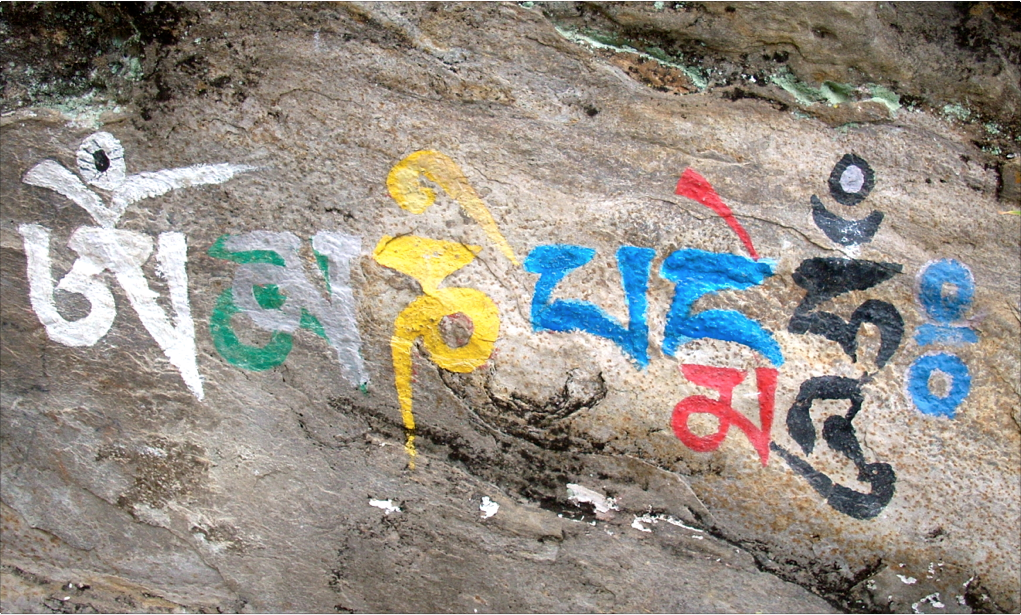Om mani padme hum, Om mani padme hum, Om mani padme hum…
In Kathmandu, around Boudhanath Stupa, there is a shop with big speakers in front that plays a melodic version of this mantra. It’s accompanied by the low murmur of locals as they walk around and around the stupa with this mantra spilling over their mala beads to create the heartbeat of the village. From my first time around the stupa, taking in all its marvelous sights, smells and sounds, the mantra got its grips on me. I love the idea of it, this continual pledge to develop compassion (mani) and wisdom (padme) as a means to transform the way we view the world.
These Tibetan words are the subject of vast translation and are said to capture the essence of the Buddha’s teaching - the dharma. The monks and Buddhist laypeople of Nepal paint and carve these letters on walls and stones in many places throughout their sacred landscape. In 2010 I snapped a photo of one such wall at a monastery known as Namo Buddha and pulled it up frequently in the years that followed. It prompted me to dig deeper into its meaning and its use as a mantra. “Man” means mind and “tra” means to cross over – a mantra is a meditative device that when repeated helps to protect, focus and calm the mind. I began to use the mantra myself and in time it occurred to me that maybe I’d get it tattooed on my body (‘cause I need frequent reminding) which I did a couple years ago – on my right forearm – to remind me….
Every day we come to junctures, moments that require us to act. One way to look at these moments is with regard to their potential consequences. Outcomes that vary widely in their potential impacts and that can be placed into three general buckets: negative, neutral or positive. Part of my own practice has become to apply the lens of this mantra to my actions – to remind myself continually to at least try to put myself in other being’s shoes and to remember that nothing is permanent – everything around us is changing all the time.
Our human condition involves varying amounts of suffering. It simply comes with the territory of inhabiting this body. When we can remember that we’re not alone in our suffering and further that it’s temporary, well, hopefully the result is alleviation of suffering through the creation of space. Space to feel, space to accept, space to forgive, space to let go and space to carry on. Lack of space – when we feel crowded by our thoughts, cramped by our position, boxed in by our actions, unable to express ourselves, inhibited by others opinions is dukkha (suffering/dissatisfaction) – these are all ways in which space is not available to us resulting in anxiety, fear, depression, anger, jealousy, greed, doubt and all their companions that cause us to want to crawl into a hole and stay there possibly becoming even more boxed in by our own fight or flight reactions.
So, on this past trip to Nepal, when I sat down with my teacher, Tokpa Tulku, I asked him about this mantra. He described “Om” as the result or goal of practice, that being to develop the body, speech and mind of a Buddha. The Buddha represents our ability to overcome the trappings of the thinking mind – the wisdom that manifests once the obscurations of thought are gone – once the mind rests and allows peace, i.e, space, to come.
“Mani” and “padme” describe the path to Buddhahood. Mani symbolizes compassion – the practice of repeatedly opening one’s heart to the suffering of others, to develop an appreciation for the shared struggles of sentient beings. This alleviates some of the pressure we all feel because it creates a more even playing field – where we no longer feel alone. There is the camaraderie of shared struggle – when we set our ego aside and recognize one another as ourselves.
Padme symbolizes wisdom – the overturning of ignorance – the deep seated belief and grasping to the idea that there is permanence. Relinquishing this notion we are able to allow for the potential that lies within the present moment – within the purity of the spaciousness that lies at our core and gets buried deep by our ego-driven struggles to create an identity we can be “proud” of.
The last syllable, “hum”, is the exclamation point – it emphasizes the importance of balanced development of these qualities. Tokpa Tulku said “we are working to engage both of these (mani and padme) equally, to develop a balanced practice that will shape our fundamental view” and “remember, they must complement each other, not negate”.

